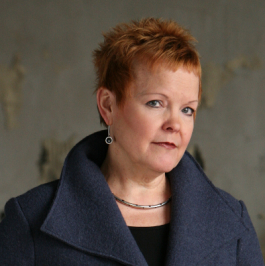
Jennifer Goulet
Jennifer Goulet is the president and CEO of Creative Many, Michigan's creative sector advocacy organization.
Model D: Talk about Creative Many Michigan and its mission. What is the group all about and how did it originate and develop into what it is now?
Jennifer Goulet: Creative Many is a statewide organization whose mission is to develop creative people, creative places, and the creative economy for a competitive Michigan through research, advocacy, professional practice, and communications.
Formerly ArtServe Michigan, we launched our new brand as Creative Many in September 2014 to strengthen our focus on advancing Michigan's creative economy – for-profit and nonprofit – while engaging the diverse array of players in the creative and design industries – artists, arts, and cultural organizations, designers, creative practitioners, entrepreneurs and businesses: Michigan's "Creative Many."
We've a main office in TechTown Detroit and our public policy office is located in The Runway, a fashion incubator space in downtown Lansing.
MD: There was discussion at Creative Many's recent policy summit about state and local governments' role in developing the creative economy. There was also some criticism of the lack of foresight on the part of government regarding the economic impact of arts and culture. What is the next step in attempting to change political will (in Lansing, in particular) to see the value of creative industries?
JG: Creative Many's research has raised new levels of awareness for the significant economic contributions that the arts, culture, and creative and design industries bring to Michigan's economy and the vitality of communities statewide. The creative and design industries are a powerful economic force on their own, generating jobs, business growth, and economic activity while creativity and design are essential and integral resources across all industrial sectors in our economy.
We have important work ahead to continue to elevate understanding of the untapped economic potential of these industries, to equip local and state leaders with resources and tools to position these industries as priorities in economic development planning, to strengthen investment, resources and networks to cultivate sector growth, and position Michigan's creative economy for competitive advantage in the U.S. and internationally.
We're also cultivating bi-partisan leadership for the Michigan Legislative Creative Caucus to work in partnership to advance a six-part agenda: creative economy; creative talent; creative education; creative placemaking; trade and export opportunities; and investment in Michigan's arts, culture, creativity, and design.
MD: There was also much discussion about creative education and how it can help stimulate a more creative economy. Talk a bit more about creative education and the efforts to add the arts to the STEM educational philosophy.
JG: An education where the arts and creative learning opportunities are woven across a curriculum equips students with the skills in innovative thinking and problem solving that are vital to cultivating the workforce for businesses into the future. Creativity and innovation are leading skills sought by corporate leaders according to CEO surveys conducted by the Conference Board. Integration of the arts and creative learning in our pre-K through 12 educational systems is essential to workforce development.
There are amazing opportunities for students to choose vibrant career pathways in the arts, and there are amazing opportunities to utilize creative learning experiences to shape and equip students to pursue successful careers in science, technology, engineering, and math.
Creative Many is excited to be leading a team of Michigan arts education experts as part of a national 10-state pilot developing innovative strategies for arts education in partnership with our national partner, Americans for the Arts.
MD: Creative Many will publish a special report in early 2016 that includes data to support the multiple narratives delivered at its recent policy summit. That is, that a robust creative economy is good for the state of Michigan, for the city of Detroit, and other cities and regions in the state. Can you give us a quick preview of what we can expect in the report?
JG: Our Phase 2 Creative and Design Industries study is slated for release in January 2016 and will share updated data and analysis to define the types of jobs and businesses that comprise the creative and design industries at the state level and in key regions – Detroit, Grand Rapids, Ann Arbor, and Flint – leading hubs for these industries in Michigan.
The study will take a closer look at the critical role of creative jobs and enterprises in leading industries like automotive or furniture, and explore the role of the creative sector in cultivating talent for businesses in the future, seeding innovation and growth opportunities across industrial sectors, and adapting strategically to an economy where automation and digitization are ever evolving.
We'll share case studies that share experiences of local artists, groups, businesses, and entrepreneurs that bring the data to life and affirm the opportunities and challenges facing Michigan's creative sector. We'll also share recommendations for needed investments, strategies, and networks to cultivate sector growth, while raising new questions and needs for additional research and analysis to ensure that we maximize our understanding of the power of Michigan's creative economy and position it strategically for growth and prosperity.
The study will affirm the untapped growth potential for these industries in Michigan and increase strategic focus on the power of the creative sector in state and local economic development priorities.
More information about Creative Many can be found here. Video from September's policy summit can be viewed here.